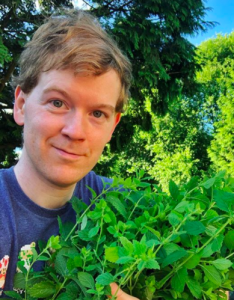Introduction
 Greetings,
Greetings,
My name is Neill McCallum (he/him/his) and I am in my third term for the Masters of Education Technology (MET) program with the University of British Columbia.
I have been teaching secondary school for the past 6 years for the Richmond School District (British Columbia, Canada). My specialization is in biological sciences and secondary education but I have also worked as an education consultant for sustainability in my school district.
As an educator, I usually teach a diverse mix of material but my reliance on technology for improving the learning experience is quite high. Whether teaching in person or online, I truly value the freedom and possibilities created with technology and this was my motivation to enroll in the MET program.
What’s in my bag?
Here is an image that was taken recently of everything I carry around in my backpack to work. There is a water bottle, hand-cream, keys, whistle, pen, marker, disinfecting wipes, pamphlets on environmental conservation, a diagram showing the lifecycle of mason bees, education-focused books, and a laptop.
Of all the items in my bag, the one I need the most frequently is my laptop. It is a gateway of communication with the outside world, and an instrument that allows me to teach, learn, and complete daily tasks.
The collection of pamphlets on environmental conservation reflect my passion for protecting the environment but also tells me how much I enjoy hoarding handout materials as they were all acquired over a year ago.
The education books support my desire to develop my skills and experience as an educator, and the sanitizing wipes are a protection measure I use to prevent the spread of the unfortunate virus we have been plagued by for the past 18 months.
Text Technologies
I have experience working as a pre-press technician and have seen books and newspapers made, “hot off the presses”, and though more and more text is becoming digital, printed works are still a staple of communicating facts, ideas, imaginations, and dreams.
The books, pamphlets, labels, and laptops are all connected to digital texts as they were either created directly on a digital device or were formatted through one to be printed.
There are many codes and detailed texts on the sanitizing wipes, hand-cream, and books that are intended for manufacturing information that a common person is not meant to understand but they do serve a purpose, much like the coloured circles on product packaging that tell the printers if they have achieved the correct colour or not.
I am a visual person, and although many of my bag’s items do not contain text, there is a lot of communication coming through the imagery and formatting. The diagram of the mason bee lifecycle is very visual and effectively helps the observer understand the topic with minimal textual components. My water bottle exposes First Nations culture with its artwork that symbolizes elements of the land and nature without using any form of text.
The whistle and laptop provide audio signals of communication. The laptop can be linked back to text technologies as when I hear my e-mail inbox chime it draws me to read digital text, and the laptop itself is also running through its own formula language of coded digital text to complete tasks.
The items in my bag suggest that I have an understanding of many different literacies. The laptop suggests digital, media, visual, computational, and foundational literacy. The books and pamphlets also suggest foundational and visual literacy, and the sanitizing wipes suggest ethical literacy as I hold a responsibility to protect others from harm.
Final Thoughts
After reviewing the contents of my bag I can say that they are an accurate representation of who I am and what I do. The outdoor photo of myself holding plants appears to match well with the contents of my bag and I do not think would be a surprise to anyone.
I think that if an archeologist were to uncover my bag many years into the future they would believe my time period to be influenced by digital technology but not entirely replaced as there are still printed works.
If we were to travel back in time 25 years I would say my bag would not have any electronics and would be more focused on printed text and instruments to record on paper. My bag would also be a lot heavier as I would be carrying textbooks, scribblers, and binders.
Analyzing the different forms of text technologies (or lack thereof) has my mind assessing this element of communication and is a great way to start thinking about text technologies.

